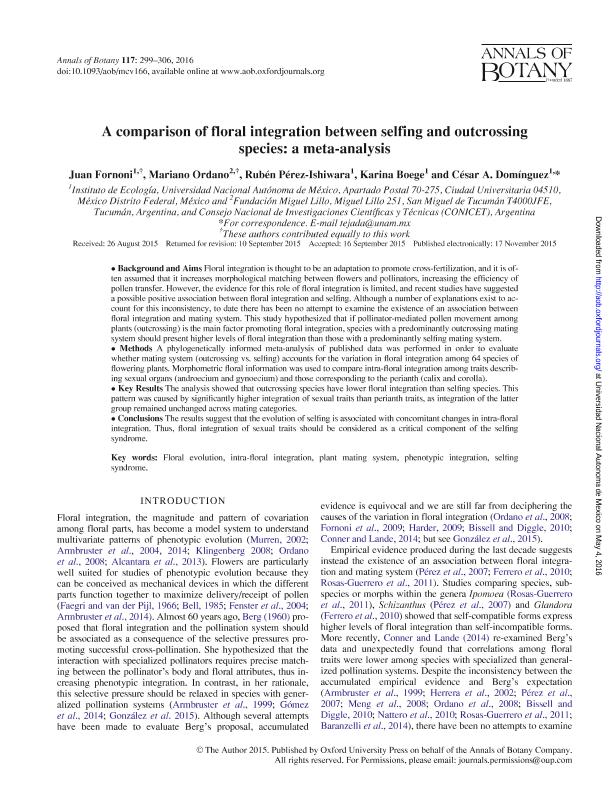Mostrar el registro sencillo del ítem
dc.contributor.author
Fornoni, Juan
dc.contributor.author
Ordano, Mariano Andrés

dc.contributor.author
Pérez Ishiwara, Rubén
dc.contributor.author
Boege, Karina
dc.contributor.author
Domínguez, César A.
dc.date.available
2018-08-21T15:49:11Z
dc.date.issued
2016-02
dc.identifier.citation
Fornoni, Juan; Ordano, Mariano Andrés; Pérez Ishiwara, Rubén; Boege, Karina; Domínguez, César A.; A comparison of floral integration between selfing and outcrossing species: A meta-analysis; Oxford University Press; Annals of Botany; 117; 2; 2-2016; 299-306
dc.identifier.issn
0305-7364
dc.identifier.uri
http://hdl.handle.net/11336/56330
dc.description.abstract
Background and Aims Floral integration is thought to be an adaptation to promote cross-fertilization, and it is often assumed that it increases morphological matching between flowers and pollinators, increasing the efficiency of pollen transfer. However, the evidence for this role of floral integration is limited, and recent studies have suggested a possible positive association between floral integration and selfing. Although a number of explanations exist to account for this inconsistency, to date there has been no attempt to examine the existence of an association between floral integration and mating system. This study hypothesized that if pollinator-mediated pollen movement among plants (outcrossing) is the main factor promoting floral integration, species with a predominantly outcrossing mating system should present higher levels of floral integration than those with a predominantly selfing mating system. Methods A phylogenetically informed meta-analysis of published data was performed in order to evaluate whether mating system (outcrossing vs. selfing) accounts for the variation in floral integration among 64 species of flowering plants. Morphometric floral information was used to compare intra-floral integration among traits describing sexual organs (androecium and gynoecium) and those corresponding to the perianth (calix and corolla). Key Results The analysis showed that outcrossing species have lower floral integration than selfing species. This pattern was caused by significantly higher integration of sexual traits than perianth traits, as integration of the latter group remained unchanged across mating categories. Conclusions The results suggest that the evolution of selfing is associated with concomitant changes in intra-floral integration. Thus, floral integration of sexual traits should be considered as a critical component of the selfing syndrome.
dc.format
application/pdf
dc.language.iso
eng
dc.publisher
Oxford University Press

dc.rights
info:eu-repo/semantics/openAccess
dc.rights.uri
https://creativecommons.org/licenses/by-nc-sa/2.5/ar/
dc.subject
Floral Evolution
dc.subject
Intra-Floral Integration
dc.subject
Phenotypic Integration
dc.subject
Plant Mating System
dc.subject
Selfing Syndrome
dc.subject.classification
Otras Ciencias Biológicas

dc.subject.classification
Ciencias Biológicas

dc.subject.classification
CIENCIAS NATURALES Y EXACTAS

dc.title
A comparison of floral integration between selfing and outcrossing species: A meta-analysis
dc.type
info:eu-repo/semantics/article
dc.type
info:ar-repo/semantics/artículo
dc.type
info:eu-repo/semantics/publishedVersion
dc.date.updated
2018-08-17T16:55:02Z
dc.journal.volume
117
dc.journal.number
2
dc.journal.pagination
299-306
dc.journal.pais
Reino Unido

dc.journal.ciudad
Oxford
dc.description.fil
Fil: Fornoni, Juan. Universidad Nacional Autónoma de México; México
dc.description.fil
Fil: Ordano, Mariano Andrés. Consejo Nacional de Investigaciones Científicas y Técnicas; Argentina. Fundación Miguel Lillo; Argentina
dc.description.fil
Fil: Pérez Ishiwara, Rubén. Universidad Nacional Autónoma de México; México
dc.description.fil
Fil: Boege, Karina. Universidad Nacional Autónoma de México; México
dc.description.fil
Fil: Domínguez, César A.. Universidad Nacional Autónoma de México; México
dc.journal.title
Annals of Botany

dc.relation.alternativeid
info:eu-repo/semantics/altIdentifier/doi/https://dx.doi.org/10.1093/aob/mcv166
dc.relation.alternativeid
info:eu-repo/semantics/altIdentifier/url/https://academic.oup.com/aob/article/117/2/299/2195683
Archivos asociados
